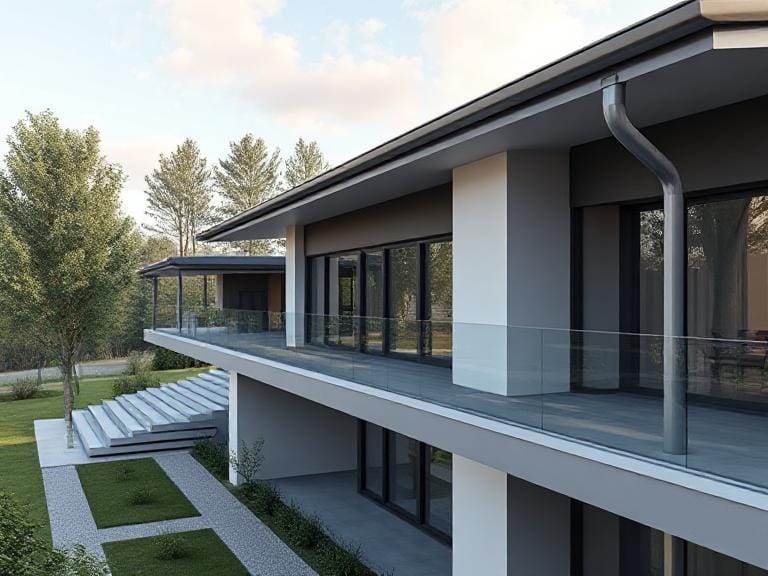The Role of Gutters in Protecting Your Roof’s Integrity
Gutters are essential components of both residential and commercial roofing systems, designed to manage the flow of rainwater. They are typically made from various materials such as aluminum, vinyl, copper, or steel, each offering unique benefits in terms of durability, weight, and aesthetic appeal. The basic structure of a gutter includes a channel that collects rainwater as it cascades off the roof, directing it to downspouts that carry the water away from the building’s foundation.
There are several different types of gutters, including K-style, half-round, and box gutters. K-style gutters, which have a flat bottom and angled front, are the most common due to their ability to handle varying levels of rainfall and their effective aesthetic fit in modern architectural styles. Half-round gutters offer a more traditional look and are easier to clean, whereas box gutters are built into the roof structure and are particularly useful for larger buildings where high water volume is expected.
The primary function of gutters is to channel rainwater away from the roof and the foundation of the building, preventing moisture accumulation that can lead to significant water damage or roof decay. Proper installation of gutters is critical; misalignment can cause water pooling on the roof or around the building’s perimeter, increasing the risk of erosion, flooding, or structural damage. Regular maintenance such as cleaning debris and ensuring free flow of water through the system is also vital to ensure they remain effective over time.
Moreover, gutters play a crucial role in the overall drainage systems of properties. They work in conjunction with downspouts and drainage pipes to ensure that water is efficiently diverted away from sensitive areas. By maintaining the integrity of gutters, property owners can protect their roofs and foundations, extending the lifespan of their structures and safeguarding against potential water-related issues.
How Gutters Prevent Roof Damage
Gutters serve a vital function in the overall maintenance and protection of a roof’s integrity. One of their primary roles is to facilitate proper water drainage from the roof, channeling rainwater away from the structure. When gutters become clogged or damaged, water can pool on the roof surface. This pooling can cause significant damage over time, as stagnant water may penetrate the roofing materials, leading to leaks and subsequent structural issues.
Another critical aspect of gutter functionality is its role in preventing ice dams during colder months. When gutters are blocked, melting snow can accumulate at the roof’s edge, leading to the formation of ice dams. These dams obstruct further runoff, resulting in water backing up under shingles and eventually leaking into the home. This scenario not only compromises the roof’s efficiency but can also lead to mold growth and deterioration of interior walls and ceilings.
Moreover, consistent water drainage through functioning gutters minimizes the wear and tear on roofing materials. Excess moisture can break down materials such as shingles or tiles, causing them to become brittle and less effective at shielding the home from environmental elements. For instance, a case study in a suburban neighborhood revealed that homes with inadequately maintained gutters experienced roof damage up to three times faster than homes with well-maintained systems. Homeowners faced costly repairs due to premature shingle replacement and structural damages that could have been avoided.
Ultimately, proper maintenance and functioning of gutters are essential for safeguarding a roof’s lifespan, highlighting their crucial role in preventing potential roof damage. Regular inspections and cleaning can significantly reduce these risks, ensuring a strong protective barrier against the elements.

Maintenance Tips for Your Gutters
Maintaining your gutters is crucial for ensuring they function effectively and contribute to the overall integrity of your roof. Regular upkeep can prevent costly repairs and extend the lifespan of your roofing system. Begin with routine cleaning; at least twice a year, inspect your gutters for debris, such as leaves, twigs, and dirt, which can obstruct water flow. Clogged gutters can lead to overflow, causing water damage to your roof and foundation.
In addition to cleaning, regularly check your gutters for any clogs that may be hidden from plain view, especially in regions experiencing heavy rainfall. Inspect the downspouts as well, ensuring that water drains away from your home’s foundation. A simple test is to run water from a hose through the gutters and observe if it’s draining properly. If you notice pooling water or slow drainage, it may indicate a clog that needs to be addressed.
Inspecting gutters for signs of damage is another vital part of maintenance. Look for cracks, rust, or separation at the seams, as these issues can lead to leaks and ineffective drainage. Additionally, ensure that your gutters are properly aligned. Gutters should tilt slightly toward the downspouts to facilitate the flow of water. If you find any misalignments, adjust the hangers to ensure optimal performance.
The frequency of gutter maintenance can vary depending on your local weather conditions. In areas with heavy foliage or rainfall, it may be necessary to clean and inspect them more frequently, potentially every three months. Watch for red flags, such as water stains on walls or ceilings, which can signal that gutter maintenance has been neglected. By proactively addressing these areas, you can maintain the functionality of your gutters and protect the integrity of your roof effectively.
When to Seek Professional Help
Homeowners may often approach gutter maintenance with a DIY mindset, believing it to be a straightforward task. However, there are pivotal moments when engaging a professional gutter service becomes essential. Recognizing the signs of significant problems is crucial in ensuring the longevity and integrity of your roof and overall property. One of the primary indicators that professional help is needed is the presence of persistent leaks. If water consistently pools around your foundation or if you notice damp spots on walls, it indicates improper drainage, which may require an expert assessment.
Another clear sign is visible structural damage, either to the gutters themselves or around the roof area. If you observe sagging gutters, broken or missing sections, or any rust formation, these are substantial issues that typically exceed the capacity of basic home repairs. Additionally, signs like mold growth or the presence of pests in your attic can also signal that water management through gutters is inadequate, necessitating a professional’s eye.
When searching for reliable gutter service providers, it is prudent to look for certified professionals with positive customer reviews and appropriate insurance. Professional installation and maintenance offer distinct advantages over DIY approaches. Experts possess the skills and tools necessary to identify potential issues, ensuring that your gutters function optimally to direct rainwater away from your roof and foundation. Although the cost of professional services may seem steep upfront, the potential long-term savings from preventative care often outweigh these initial expenses. By addressing gutter issues early, homeowners can avoid costly repairs associated with water damage and structural instability.







